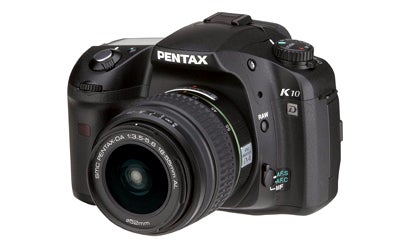Hands on With the Pentax K10D
This 10.1MP DSLR is built for speed, endurance, and price ($899 street).

We may earn revenue from the products available on this page and participate in affiliate programs. Learn more ›
In the boisterous parade of new 10-megapixel DSLRs, here comes the tough guy of the bunch, the Pentax K10D. This new model packs 10MP capture, CCD-based image stabilization, a self-cleaning sensor, and compatibility with an extensive lens system into what is probably the best-sealed DSLR body in the sub-$1,000 class. At $999 (estimated street) with the 18-55mm f/3.5-5.6 Pentax DA lens, or $899 for the body only, it’s a tough deal to beat, too.
We knew Pentax had a 10MP DSLR coming, but we didn’t quite expect this level of construction and capability. Details:
The 10.1MP CCD imager captures up to 3872×2592-pixel images in JPEG, RAW, or simultaneous RAW + JPEG. RAW capture, moreover, can be in Pentax’s proprietary PEF or Adobe DNG format.
Analog-to-digital image file conversion is done at 22 bits per color rather than the usual 12 bits — a first. The theory: The more information going in, the better the color and detail in the final image. But final RAW files are stored at only 12 bits per color, so we’ll see how much the fancier conversion helps when we test a production model.
It writes to SD/MMC cards and can use new, higher-capacity SDHC cards.
With a new, faster processing engine, highest-quality JPEGs can be captured at 3 frames per second in a burst limited only by the capacity of the card.
The CCD can shift vertically, horizontally, or rotationally to counteract hand shake. While similar to the Shake Reduction in Pentax’s K100D, the improved system, Pentax says, will provide a gain of up to four stops for handholding.
Unlike the K100D, this camera’s imaging sensor can be set to vibrate on camera startup or on demand to shake dust loose. The low-pass filter over the CCD also has a dust-resistant coating.
Substantial gasketing in the body (reinforced polycarbonate over a metal chassis) makes it resistant to weather and dust.
A glass pentaprism provides high viewfinder magnification of 0.95X. Focusing screens are user-interchangeable.
The 210,000-pixel, 2.5-inch LCD monitor has a 140-degree viewing angle.
The built-in pop-up flash can be used as a trigger for wireless TTL flash with one or more Pentax AF360FGZ or AF540FGZ accessory flash units, with the choice of the pop-up unit firing or not.
Additional contacts in the lensmount can provide electrical power to a lens. This allows full operation of the discontinued Pentax power zoom lenses, but, more significantly, paves the way for lenses with built-in autofocus motors.
The 11-point autofocus array (a 3×3 grid of cross sensors, plus a linear sensor on each side) is much the same as on the K100D, but Pentax claims faster lock-on and focus tracking with the new camera.
Metering choices: 16-segment evaluative, centerweighted, and central spot.
Exposure modes include Hyper Program, which allows an instant shift into aperture- or shutter-priority auto. A new Sv (for Sensitivity Priority) mode allows you to shift ISO quickly using a command dial. TAv, for Shutter & Aperture Priority, works much like Hyper Program but will automatically shift to higher or lower ISOs as needed.
A rechargeable Li-ion battery provides up to 730 shots (CIPA rating), compared with just 80 shots in the AA-powered K100D.
A battery grip ($200, estimated street) takes a second Li-ion rechargeable to double the CIPA per-charge rating to 1,460 shots, and provides a vertical shutter release.
Post-capture digital filters include black-and-white and color effects, plus things like stretch/squeeze and soft focus.
While at first glance the K10D appears to be a near clone of the *ist DS/DL and K100D cameras, it is far less menu-centered in operation. The K10D notably has two command dials (front and rear), rather than just one, speeding up manual exposure control. A rotary switch now affords quick selection of autofocusing patterns. The camera dedicates two separate buttons on the back for the autofocusing and autoexposure locks. Even RAW storage is activated by an external button.
To say that the K10D is a leapfrog camera for Pentax is an understatement. The company of late has largely concentrated on cost-cutter 6MP DSLR models — nice cameras, but nothing to rattle the competition. With the K10D, Pentax takes its place as a serious player in the current hottest category. Stay tuned for a full test soon.